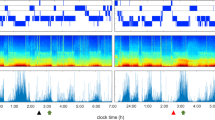Abstract
Recent studies in the rat demonstrated that systemic administration of muscimol and THIP, both selective GABAA receptor agonists, elevates slow wave activity in the EEG during non-rapid eye movement (NREM) sleep. In this placebo-controlled study, we assessed the influence of an oral dose of 20 mg THIP on nocturnal sleep in young healthy humans. Compared to placebo, THIP increased slow wave sleep by about 25 min. Spectral analysis of the EEG within NREM sleep revealed significant elevations in the lower frequencies (<8 Hz) and reductions in the spindle frequency range (≈10–16 Hz). In accordance with previous findings in the rat, these data imply that GABAA agonists promote deep NREM sleep, without suppressing REM sleep. These effects are opposite to those induced by agonistic modulators of GABAA receptors such as benzodiazepines and are at variance with established mechanisms according to which GABAA agonists and modulatory agonists would have similar effects. The sleep response to GABAA agonists is highly similar to that evoked by sustained wakefulness, suggesting that GABAA receptors may be implicated in the homeostatic regulation of sleep.
Similar content being viewed by others
Author information
Authors and Affiliations
Additional information
Received: 17 September 1996/Final version: 5 November 1996
Rights and permissions
About this article
Cite this article
Faulhaber, J., Steiger, A. & Lancel, M. The GABAA agonist THIP produces slow wave sleep and reduces spindling activity in NREM sleep in humans. Psychopharmacology 130, 285–291 (1997). https://doi.org/10.1007/s002130050241
Issue Date:
DOI: https://doi.org/10.1007/s002130050241




